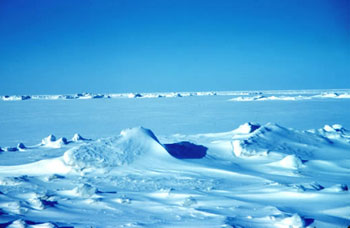Marine scientists will study coastal ecosystems in the Arctic throughout the year through a $1 million NSF grant.
 AUSTIN, Texas—University of Texas at Austin marine scientists aim to transform our understanding of coastal ecosystems in the Arctic by studying them throughout the year, including the winter and spring, times when very little research has been performed in the area.
AUSTIN, Texas—University of Texas at Austin marine scientists aim to transform our understanding of coastal ecosystems in the Arctic by studying them throughout the year, including the winter and spring, times when very little research has been performed in the area.
They were recently awarded a $1 million grant from the National Science Foundation to pursue the research.
The scientists propose that organic matter in the Alaska tundra, which enters coastal lagoons from Arctic rivers, provides an important resource for marine animals, from the tiniest crustaceans to sea birds and seals.
“In most parts of the world, it’s very well known that inorganic nutrients and organic matter from the land influence coastal productivity,” says Jim McClelland, assistant professor of marine science. “For example, we know a lot about how inputs from the Mississippi River impact the Gulf of Mexico. But in the Arctic, it’s been thought for decades that inputs from land don’t play a large role in coastal food webs.”
Marine scientist Ken Dunton says scientists have long recognized that inorganic nutrients are scarce in Arctic rivers and assumed that organic matter from river run-off in the Arctic is “locked up” and in a form that cannot support coastal food webs.
Both scientists say this assumption has largely been a result of studies conducted during summer, but massive organic matter inputs from land in the spring may be an important resource for coastal food webs throughout the year, including the deep winter, where temperatures are below freezing and ice covers the sea.
Uniquely, they will be working with local Inupiaq villagers to negotiate the Arctic ice and study the area during those months. By sampling terrestrial and oceanic waters and fauna throughout the winter and summer they will be able to demonstrate where carbon and nitrogen are coming from and ending up.
They will be collaborating with Byron Crump from the University of Maryland, a specialist in marine microbes—bacteria at the bottom of the coastal food web.
The scientists say results of the research will broadly apply to our understanding of carbon cycling and climate change. If they are correct about the role terrestrial inputs play in Arctic coastal food webs, then changes in those inputs will influence those ecosystems, which are already threatened by reduced ice and other impacts from climate change.
“These changes could also effect the local Inupiaq villages that depend on the coasts for subsistence,” says Dunton, professor of marine science.
The scientists will be studying an area along the Alaskan Beaufort Sea coast, in the vicinity of Barter Island and the Inupiaq village of Kaktovik. The Arctic National Wildlife Refuge is providing logistic support at its field site in Kaktovik.
They will also establish a summer field science program for native Kaktovik K-12 students. The Village Council there wants to involve middle school students in science activities and provide teachers from the Kaktovik school district with resources they can use to inspire student learning.
When not in the Arctic, McClelland and Dunton can be found at the university’s Marine Science Institute in Port Aransas, Texas.
For more information contact: Ken Dunton, professor of marine science, 361-749-6744; Jim McClelland, assistant professor of marine science, 361-749-6756.

















Comments